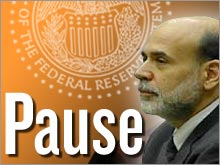Bernanke's big bet Fed policy-makers are hoping the cooling economy will stamp out inflation. But what if they're wrong? NEW YORK (CNNMoney.com) -- The Federal Reserve's latest move has investors focused on the slowing economy, but the central bank is taking a big risk if it falls behind in the battle against inflation, economists said. The Fed held interest rates steady for the first time in two years Tuesday, in effect making a big bet that, for now, slowing economic growth will take the edge off rises in inflation moving forward.
"The Fed hopes to see some sign that inflation pressures are beginning to weaken. If that's true, the Fed will be vindicated in holding at 5.25 percent," Bernard Baumohl, executive director of the N.J. research firm, The Economic Outlook Group. Many economists say that's a reasonable bet to make since there have been clear signs the economy is slowing. Growth in gross domestic product, the broadest measure of the nation's economy, slowed to a 2.5 percent rate in the second quarter from a blistering 5.6 percent in the first quarter, job growth was weak for the fourth straight month in July, and and the housing sector has been cooling for some time. But on the other side of the coin, oil prices remain not far from record highs, worldwide economic growth is still solid and now there's upward pressure on wages, as well - things that mean inflation could keep rearing its head - and throw the Fed a curve. "The real question is whether the Fed paused early," said Michael Englund, chief economist at Action Economics. "We've seen some fairly ugly inflation reports in the last couple of months," he said, noting the ongoing upward pressure on prices, even excluding things like rising oil prices. Core consumer prices, excluding food and energy, have risen 2.6 percent over the past year, exceeding the Fed's comfort zone of 1 to 2 percent for inflation. And recent numbers show that pressures persist: unit labor costs, a key measure of inflationary pressures, surged in the second quarter. Susan Phillips, a former Fed governor who is now dean of The George Washington University School of Business, said the inflation signals are still strong, but the Fed recognizes that some of the current pressures may be short-lived. "I think they believe that long-term inflation and expectations are more under control. They're seeing the current run-up in inflation easing over the next year or so," she said. Inflation's future direction There's been a consistent build up in inflation in the last few economic reports, but those readings tend to lag the economic cycle, economists said. By choosing to pause now, the Fed is making a big bet on its future direction. "Inflation is a lagging indicator. By the time Fed finally gets information that inflation is slowing, the economy could be even more depressed," said Mary Ann Hurley, vice president of fixed-income trading at D.A. Davidson. Hiking rates further now would have "sent the economy to the slaughterhouse," she said. The Fed raises rates when it wants to slow the economy and ward off inflation; it cuts them to spur growth. Right now, the central bank is trying to engineer a so-called soft landing, slowing growth and keeping inflation in check without sparking a recession. But that's a tough task. The Fed did it under former chairman Alan Greenspan in the mid-1990s but couldn't in 2000, and a recession followed. Economic readings on inflation may be backward looking, but even leading indicators show inflation remains elevated, according to Lakshman Achuthan, managing director of The Economic Cycle Research Institute, an independent group dedicated to economic cycle research. The ECRI tracks drivers of inflation, such as commodity prices, the dollar and money supply, in a bid to forecast its future direction. The institute's Future Inflation Gauge, which is closely watched by financial markets and was a favorite of Greenspan's, shows indicators peaked in late 2005, which suggests actual inflation will hit its highest point this fall, Achuthan said. "But it's premature to say we've whipped inflation," he said, noting there has yet to be a sharp downturn in the leading indicators. "We must remain guarded about being too optimistic. It's premature to say inflation's a non-issue." The Fed said in its statement that "some inflation risks remain" and left itself room to raise rates again in September. But even by then, the Fed may still be waiting for signs that its rate hike are impacting inflation. That could keep the Fed in a tough spot in the months ahead. "It's probably going to take several more months before I'm comfortable with the notion that they're truly done (raising rates)," said Michael Strauss, chief economist at Commonfund. |
| ||||||||||||||


